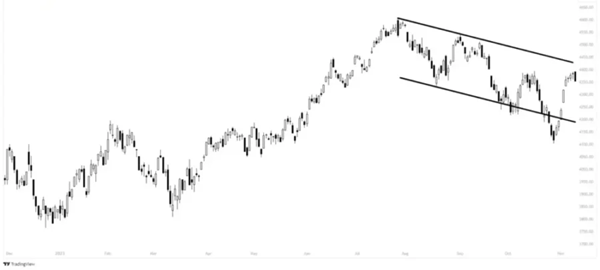Comprehensive Guide To Trading The Index
Index trading has become an increasingly popular trading approach for traders looking to capitalize on broad market movements. Indices like the S&P 500 and Dow Jones Industrial Average serve as barometers for overall market sentiment and provide exposure to hundreds of stocks within a single trade.
In this comprehensive guide, we will explore the fundamentals of index trading, outline some proven strategies, and provide actionable tips for selecting indices and executing effective index trades.
Introduction to Index Trading
Index trading involves speculating on the future price direction of major market indices like the S&P 500, Dow Jones Industrial Average, and Nasdaq 100. Think of it as trading in the direction of the broad market. Here are some key aspects of index trading:
What is Index Trading?
- Index trading allows traders to buy and sell the overall performance of a stock index through derivatives like futures, options, and ETFs.
- Instead of picking individual stocks, traders simply take a directional view of an entire index.
- Index trading provides exposure to hundreds of stocks within a single trade.
Benefits of Index Trading
- Diversification – A single index trade provides instant diversification across numerous stocks and sectors.
- Lower costs – Index trading avoids individual stock commissions by taking a single index position.
- Market exposure – Indices like the S&P 500 provide immediate exposure to overall market sentiment.
- Simplicity – Analyzing a single index is easier than picking multiple stocks.
- Liquidity – Major market indices have abundant liquidity for rapid trade entries and exits.
Types of Indices
There are stock, sector, and international indices to choose from:
- Stock indices – S&P 500, Dow Jones, Nasdaq 100, Russell 2000
- Sector indices – Energy, financials, healthcare, technology
- International indices – FTSE 100, Nikkei 225, DAX 30
Who Should Consider Index Trading?
Index trading can be suitable for:
- Technical traders – who analyze price charts and identify trade setups.
- Swing traders – looking to hold positions from days to weeks.
- Investors – aiming for long-term exposure to the overall market.
- Speculators – who want to profit from short-term index moves.
We just touched on some basics so let’s dig a little deeper…
Understanding Index Fundamentals
When trading stock indices, there are some key fundamentals to understand regarding index construction, weighting, and rebalancing:
Market Capitalization Impacts Index Prices
- Indices are market cap weighted – the largest companies have the greatest impact on index prices. As of Nov 2023, Apple had the highest market cap of $2.8 trillion
- If mega-cap stocks rise, the index will likely increase even if other components fall.
- Index prices are less impacted by small-cap stocks due to lower weighting.
Index Weighting Significance
- Market cap weighting means the largest stocks contribute the most to index price changes.
- For the S&P 500, the top 10 stocks represent over 25% of the index’s market cap weighting.
- Apple alone represents nearly 7% of the S&P 500 due to being the largest weighted stock.
Index Rebalancing Implications
- When indices like the Dow Jones or Russell 2000 rebalance, this can impact pricing.
- Adding or removing high-profile stocks changes the index weightings during rebalances.
- Rebalancing dates are known in advance – plan trades around these events.
Having an idea of how the indexes are constructed and weighted can help you predict how changes in individual components may affect the index. As of September 2023, the top 5 stocks in the S&P 500 market capitalization are Apple (AAPL), Microsoft (MSFT), Amazon (AMZN), NVIDIA (NVDA), and Alphabet Class A (GOOGL) and accounted for over 21% of the entire market cap for the index.
Index Trading Approaches To Consider
Indices provide diverse trading opportunities of the broad market direction through trend trading, swing trading, and intraday strategies. Pick one approach, master it, and then if needed, expand your toolkit of trading approaches.
Long Trading – Profiting from Rising Prices
- Buy and hold – Taking long-term long positions aiming to benefit from bullish trends over weeks, and months.
- Breakouts – Going long after indices break above resistance levels and trigger buy signals for your strategy.
- Dips buying – Using pullbacks during uptrends as long entry opportunities at lower levels.
Short Trading – Capitalizing on Falling Prices
- Short selling – Profiting from downward price moves by shorting index components.
- Range trading – Shorting at resistance when indices trade sideways within a range.
- Breakdown – Taking short positions when support levels break and prompt sell signals.
Intraday Trading – Exploiting Short-Term Moves
- Scalping – Capturing small intraday price moves for quick profits.
- News trading – Benefiting from increased volatility around key news events.
- Range trading – Fading range extremes by shorting near resistance and buying around support.
Swing Trading – Riding Medium-Term Trends
- Position trading – Holding positions for days to weeks based on daily charts.
- Chart patterns – Trading flag, wedge, and channel patterns that signal continuations or reversals.
- Momentum – Entering strongly trending prices moves in the direction of the prevailing trend.
Take your time in defining your approach to how you would handle this type of trading. Let’s take a look at news trading as an example.
The key reasons intraday traders would consider news trading are:
- News trading allows you to capitalize on short-term volatility spikes around major economic data releases, central bank announcements, and earnings reports.
- These news events create increased market movement and can expand trading ranges perfect for intraday trades.
- The defined timing of high-impact news provides clear opportunities to prepare and take advantage of reactions.
- Sharp whipsaws and breakouts often occur around news catalysts allowing for solid intraday gains especially as you gain experience.
- You can trade the index components most impacted by the news like sector ETFs or individual stocks.
- Having news event calendars and squawk feeds allows you to react quickly to profit from surging volatility. Timing is important.
In summary, news trading enables you to exploit short, intraday volatility spikes around key events making it an ideal day trading strategy for indices and stocks. By using news catalysts that impact prices, a skilled trader can capture solid gains on a daily basis.
News Trading Strategy
| Step | Action |
|---|---|
| 1 | Identify high-impact news events for the day, such as nonfarm payrolls, FOMC statements, and major earnings releases. |
| 2 | Check economic calendars for the timing of the news events and expected consensus estimates. |
| 3 | Analyze the pre-news price action and technical levels on key indexes and stock charts related to the news. |
| 4 | Determine your risk tolerance and proper position sizing based on the anticipated volatility. |
| 5 | Develop a trading plan defining your entry, exit, and stop loss levels. Factor in potential breakout levels and support/resistance. |
| 6 | As the news nears, tighten spreads by placing limit orders just above and below the current price. |
| 7 | Execute orders immediately when the news hits based on the direction of the reaction. Fade extreme spikes if momentum stalls. |
| 8 | Manage the trade and trail your stops to lock in profits as the price swings mature. Target taking partial profits along the way (scaling out). |
| 9 | Closeout positions before the volatility ends and the meat of the move begins to be given back. |
| 10 | Review the trade outcomes relative to your plan and update your strategy as needed for future news events. |
This systematic approach allows you to profit from the rapid price movements around news releases that impact the market. With practice and discipline, news trading can give consistent intraday gains.
Selecting the Right Index and Brokerage
Choosing indices aligned with your goals along with a suitable brokerage platform is key for trading success:
Identify Indices Aligned With Goals
- For broad market exposure, consider the S&P 500 or Dow Jones.
- To trade large-cap tech stocks, look to the Nasdaq 100.
- For small caps, examine the Russell 2000 or S&P 600.
- Choose sector ETFs if you want to concentrate on specific industries.
Evaluate Brokerage Trading Suitability
- Analyze commissions, fees, margin rates, and trading tools.
- Prioritize platforms with index derivatives like futures and options.
- Seek advanced charting and screening to identify trade setups.
- Make sure adequate capital and leverage are available for your strategy.
- Consider add-ons like auto-trade algos, backtesting, and trade analytics.
Executing Index Trades Effectively
Proper trade execution is vital for capitalizing on index setups, especially for intraday traders where speed is vital for success.
Placing Buy and Sell Orders
- Use limit orders to enter at desired prices instead of market orders. Market orders can be impacted by slippage.
- Be patient for pullbacks when buying and rallies when shorting to get better entries. In fast-moving indexes, the pullbacks may be shallow
- Review order types – market, limit, stop – to determine the right choice for your strategy.
Utilizing Stop-Loss and Take-Profit Orders
- Use stop-loss orders to automatically exit for a defined loss amount if the trade moves against you. Stop loss order can be affected by slippage and gaps.
- Set take-profit orders to lock in gains if the index reaches your upside target. Consider risk profit targets such as 1, 2, or 3 times your initial risk.
- Adjust stop-loss levels to protect profits as the trade moves favorably. Consider trailing your stop under swing low points.
Managing Risks Through Position Sizing
- Size positions appropriately to avoid excessive risk – risk only 1-2% of capital per trade and also consider overall portfolio risk
- Scale position size based on your stop distance to contain potential losses. Using the same dollar amount for each trade is a lazy way to position size.
- Diversify trades across indices and sectors to reduce risk. This is especially important if holding trades as swings or position trades.
Improve Your Index Trading Knowledge
Ongoing learning and market awareness separate successful traders from the rest. Some suggest regardless of your trading experience, incorporating demo trading and constant backtesting is an important learning process.
Monitor Economic Indicators and News
- Follow key reports like jobs data, GDP, and inflation that can impact indices.
- Watch Fed decisions and statements for hints on interest rate policy.
- Stay updated on earnings from major companies that are heavily weighted in the index.
- Subscribe to economic calendars to know when potential volatility events are scheduled. Getting alerts each morning prior to the session keeps you “in the loop” for the trading day.
Utilize Technical Analysis Tools
- Use indicators like moving averages to identify trading ranges and trends.
- Watch for overbought and oversold signals from oscillators like RSI and MACD.
- Backtest chart patterns to verify they produce an edge over time. I find practicing chart patterns a valuable exercise as it conditions you to spot these quickly.
Keep Informed of Index Developments
- Follow index-specific news like rebalancing changes, new derivative products that are added
- Note historical seasonality tendencies for indices to identify annual trading opportunities.
- Regularly check index futures curves and option skews for insights on sentiment.
By following the outlines in this guide, you set yourself up to be not only an educated trader but also a successful one.
Conclusion: Starting To Index Trade
There is a lot to digest in this guide but I think it is important for you to be fully immersed in the information that could give you an edge.
Strategies and Fundamentals
- Utilize directional, swing trading, and intraday strategies based on index price action.
- Understand market cap weighting, rebalancing, and construction methodology.
- Trade market exposure, sectors, or international indices aligned to your goals.
Emphasis on Risk Management
- Use stop losses on all trades along with prudent position sizing.
- Maintain diversification across uncorrelated indices and assets.
- Only risk 1-2% of capital per trade to survive normal trading drawdowns.
Seek Guidance and Demo Trade
- Read books, take training courses, and learn from mentors to accelerate success.
- Develop your skills risk-free through demo trading before risking capital.
- Join an online trading community to exchange ideas and stay motivated.
Index trading presents traders with a smart way to gain broad market exposure, capitalize on sector rotations, and profit from short-term volatility. By understanding index construction, utilizing technical and fundamental analysis, and implementing solid risk management, traders can develop their own unique index trading strategy that suits their objectives.
Follow the points outlined here for constructing a trading plan, refining skills with demo trading, and continuing to educate yourself on the market as a whole.
This post originally appeared at NetPicks.
Category: Options Trading





